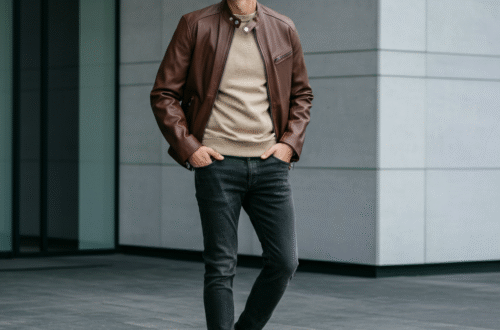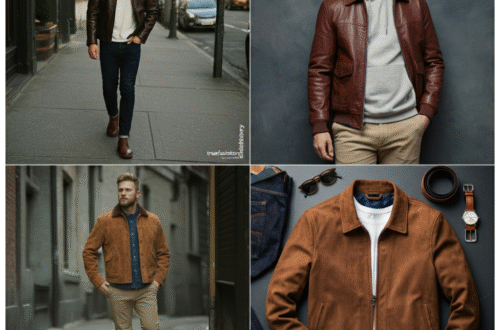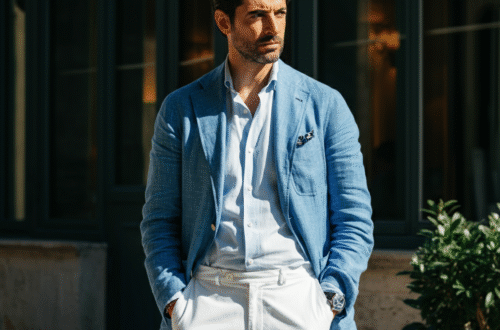The 1970s was a decade of bold expression, and nowhere was this more evident than in men’s fashion. From the earthy tones of the early years to the glitz of the disco era, seventies fashion for men was all about breaking rules and embracing individuality. This was a time of significant social change, and the clothes reflected a new sense of freedom. Men moved away from the rigid suits of previous decades and experimented with vibrant colors, new fabrics like polyester, and figure-hugging silhouettes. Whether you’re looking to add a vintage touch to your wardrobe or go all out for a themed party, understanding the key elements of 70s style is your first step. This guide will walk you through the iconic looks, essential pieces, and lasting influence of this unforgettable decade in fashion.
Key Takeaways
- A Decade of Diversity: The 70s wasn’t one single look but a mix of styles, including hippie, glam rock, disco, and punk.
- Signature Silhouettes: Key shapes included bell-bottom pants, wide lapels on jackets, and tight-fitting shirts.
- Color and Fabric: Earth tones were popular, but so were bright, bold colors. Polyester was the fabric of the decade, alongside denim, corduroy, and velvet.
- Accessorize Freely: Platform shoes, wide belts, statement necklaces, and oversized sunglasses were essential for completing any 70s outfit.
- Enduring Influence: Many seventies fashion mens trends, like flared pants, corduroy jackets, and bold prints, continue to inspire modern designers and style enthusiasts.
The Cultural Backdrop of 70s Men’s Fashion
To truly understand seventies fashion for men, you have to look at what was happening in the world. The decade was a melting pot of cultural movements. The peace and love ethos of the late 60s hippie movement carried over, influencing a more relaxed, natural style with long hair, denim, and earthy colors.
At the same time, the music scene had a massive impact. Glam rock, with stars like David Bowie, introduced an androgynous, theatrical look with glitter, satin, and platform boots. Later in the decade, disco music brought its own uniform: slick three-piece suits, shimmering polyester shirts, and gold chains, perfect for a night on the dance floor. Even the rise of punk rock towards the end of the 70s made its mark with ripped clothes, leather jackets, and a DIY attitude. This mix of influences meant that men’s fashion was more diverse than ever before. It was a clear departure from the more uniform styles of the 50s and 60s, allowing men to express their personalities through their clothes.
From Hippie to Peacock Revolution
The early 70s saw the continuation of the “Peacock Revolution” that began in the late 60s. Men started to embrace clothing that was traditionally seen as feminine, including vibrant floral prints, flowing fabrics, and heeled shoes. This wasn’t just about rebellion; it was a celebration of individuality. The hippie influence brought in elements like tie-dye, headbands, and fringed jackets. Denim became a staple, often personalized with patches and embroidery. This casual, eclectic look was a direct contrast to the formal business attire that had dominated men’s closets for so long. It was a style that valued comfort and self-expression above all else.
Iconic Pieces of Seventies Fashion for Men
Certain garments scream “1970s” the moment you see them. These iconic pieces defined the decade and are essential for anyone looking to recreate the style.
Bell-Bottoms and Flares: The Defining Silhouette
If one item of clothing defines the 70s, it’s the bell-bottom. These pants were snug at the thigh and flared out dramatically from the knee down. They came in every material imaginable, from classic blue denim and soft corduroy to flashy, printed polyester. Flares were a universal trend, worn by rock stars, disco dancers, and everyday people alike. The wide leg created a unique silhouette that was often balanced with a tight-fitting shirt on top. This look was bold and confident, symbolizing the free-spirited nature of the era. Exploring different styles on sites like truefashionstory.com can show you how these vintage pieces are being reinterpreted today.
The Rise of Polyester and Leisure Suits
Polyester was the miracle fabric of the 1970s. It was cheap, durable, and came in a dazzling array of colors and patterns. This made it the perfect material for one of the decade’s most infamous creations: the leisure suit. A leisure suit was a casual alternative to a traditional business suit, typically consisting of a shirt-style jacket and matching trousers. Often seen in pastel shades like baby blue, mint green, or beige, it was the go-to outfit for a Saturday night out. While it might seem dated now, the leisure suit represented a move towards more comfortable and relaxed formalwear. It was a symbol of modern convenience, a suit you could throw in the wash without a second thought.
The Wide-Lapel Suit Jacket
Even formalwear got a groovy makeover in the 70s. Suit jackets, blazers, and sport coats were distinguished by their dramatically wide lapels. Often paired with flared trousers, these jackets created a powerful V-shape torso. They came in a variety of fabrics, including velvet for evening wear and textured tweeds for daytime. The colors were often bold, with shades like burgundy, forest green, and mustard yellow becoming popular choices. This style was all about making a statement, turning the traditional suit into something much more exciting and expressive.
Casual vs. Evening Wear in the 70s
How a man dressed in the 70s depended heavily on the occasion. Daytime and nighttime looks had distinct characteristics, though both shared a flair for the dramatic.
|
Feature |
Casual/Daytime Wear |
Evening/Disco Wear |
|---|---|---|
|
Pants |
Denim bell-bottoms, corduroy flares |
Polyester or satin flared trousers |
|
Shirts |
T-shirts, Henley shirts, plaid button-downs |
Open-collar shirts, silk or satin shirts |
|
Jackets |
Denim jackets, suede jackets, corduroy blazers |
Three-piece suits, velvet blazers |
|
Colors |
Earth tones: brown, orange, green, mustard |
Bright colors, metallics, white |
|
Footwear |
Sneakers, work boots, sandals |
Platform shoes, loafers |
Everyday Style: Comfort and Individuality
For everyday wear, comfort was key. The seventies fashion mens look for daytime was relaxed and heavily influenced by workwear and hippie culture. Denim was everywhere, from flared jeans to vests and jackets. T-shirts, often with band logos or graphic prints, were a popular choice. Another staple was the plaid or flannel shirt, worn open over a tee. Corduroy was another favorite fabric for its softness and durability, used for everything from pants to blazers. This casual style was practical but still allowed for personal expression through patches, pins, and accessories.
A Night at the Disco: Glamour and Glitz
When the sun went down, the glitter came out. Disco fashion was all about being seen. The goal was to shine under the disco ball, so shimmering, reflective fabrics were a must. Men embraced tight-fitting, high-waisted trousers, often in white or bold colors. These were paired with silky polyester shirts unbuttoned low to show off a hairy chest and a gold medallion. The three-piece suit made a huge comeback, but this time in light colors and with a disco-ready flared leg. It was a look that exuded confidence and a love for the nightlife.
The Must-Have Accessories of the Decade
No 70s outfit was complete without the right accessories. These details were crucial for pulling the whole look together.
Platform Shoes: Reaching New Heights
Platform shoes were a defining footwear trend for both men and women. They added inches of height and a whole lot of attitude. Men’s platform shoes ranged from modest one-inch soles on loafers to towering boots that would give you vertigo. They came in all styles, from casual boots to flashy disco shoes covered in glitter. While they might not have been the most practical footwear, they were undeniably cool and a symbol of the decade’s larger-than-life style.
Belts, Jewelry, and More
Accessories were not an afterthought; they were a centerpiece of seventies fashion for men. Belts became wider and featured large, ornate buckles. They were worn with everything from jeans to suits. For jewelry, the gold medallion necklace, nestled in a sea of chest hair exposed by an open-collared shirt, is an iconic image. Men also wore rings, bracelets, and even puka shell necklaces. To top it all off, oversized sunglasses, especially aviator styles, were the ultimate cool-guy accessory.
Hairstyles and Grooming in the 70s
Hair was just as important as the clothes. The 70s saw a move away from the short, neat hairstyles of previous decades. Longer hair became mainstream for men, from shaggy, layered cuts to shoulder-length locks. The “feathered” look, popularized by celebrities, was a go-to style.
Facial hair was also extremely popular. Thick sideburns, full beards, and especially mustaches were seen everywhere. The handlebar and the chevron mustache were particularly iconic. This trend towards more hair, both on the head and face, was part of the overall move towards a more natural and relaxed aesthetic, rejecting the clean-cut look of the corporate world.
The Enduring Legacy of 70s Men’s Fashion
Decades later, the influence of seventies fashion for men is still going strong. High-end designers and fast-fashion brands alike continue to draw inspiration from this expressive era. The flare and bootcut jean styles make regular comebacks, offering a flattering alternative to skinny jeans. Corduroy jackets, shearling coats, and bold, printed shirts are all items you can easily find in stores today. The 70s taught us that fashion can be fun, bold, and a powerful tool for self-expression. It broke down boundaries and created a more diverse and exciting landscape for men’s style, a legacy that continues to inspire.
Frequently Asked Questions (FAQ)
Q: What are the most essential items for a 70s look?
A: To get a classic 70s look, start with a pair of bell-bottom or flared jeans. Pair them with a tight-fitting t-shirt or a button-down shirt with a large collar. A pair of platform shoes or boots is a must. Finish the look with a wide belt and maybe some aviator sunglasses.
Q: What colors were popular in seventies men’s fashion?
A: The 70s color palette was very diverse. The early part of the decade favored earth tones like mustard yellow, olive green, brown, and burnt orange. As disco became popular, brighter colors like electric blue and vibrant red, as well as classic white and metallics, took over the dance floors.
Q: How did music influence 70s fashion?
A: Music was a primary driver of 70s fashion. Rock and folk music influenced the casual, denim-heavy hippie look. Glam rock artists like David Bowie inspired androgynous styles with satin, glitter, and platforms. Disco music created its own uniform of slick suits and shimmering shirts perfect for dancing.
Q: Can I wear 70s fashion today without looking like I’m in a costume?
A: Absolutely! The key is to incorporate elements of the style rather than wearing a head-to-toe look. Try a pair of bootcut jeans with a modern jacket, or wear a vintage-inspired printed shirt with contemporary trousers. A corduroy blazer or a suede jacket are timeless pieces that add a subtle 70s touch to any outfit.





